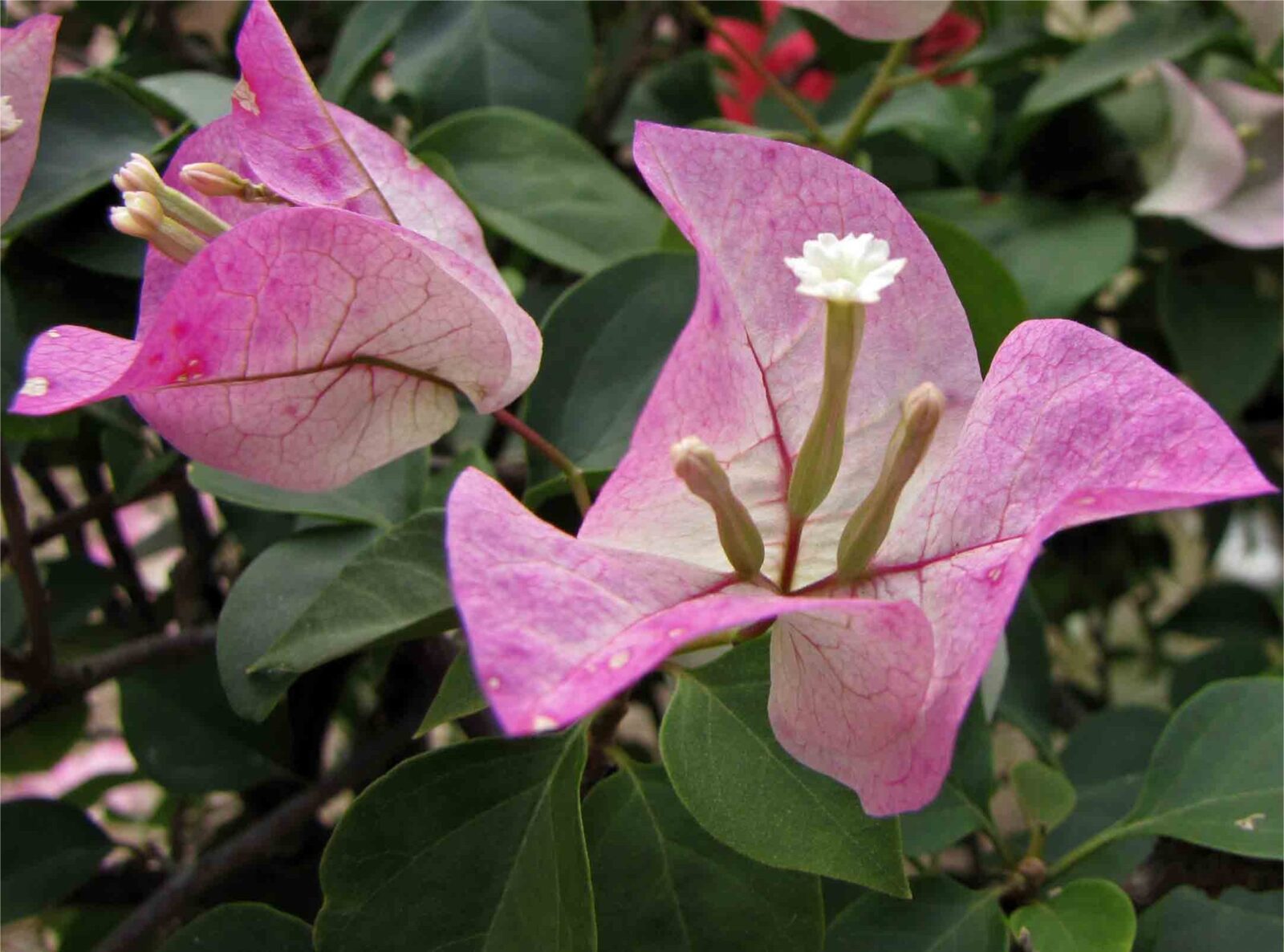Bougainvillea (pronounced boo-guhn-VIL-yuh) is a stunning and vibrant flowering plant that originates from the tropical and subtropical regions of South America. Named after the French navigator Louis Antoine de Bougainville, who discovered the plant in Brazil during the 18th century, bougainvillea is now widely cultivated for its breathtaking display of color.
Bougainvillea is a vigorous and woody vine that can either climb or sprawl depending on its surroundings. It features glossy green leaves that are ovate in shape and slightly textured. The foliage provides a lush and verdant backdrop to the magnificent flowers that steal the show.
What we often perceive as bougainvillea’s flowers are, in fact, modified leaves called bracts. The true flowers of the plant are small and inconspicuous, nestled within the center of the bracts. These bracts come in a wide range of vibrant colors, including shades of pink, purple, red, orange, yellow, and white, creating a dazzling visual spectacle.
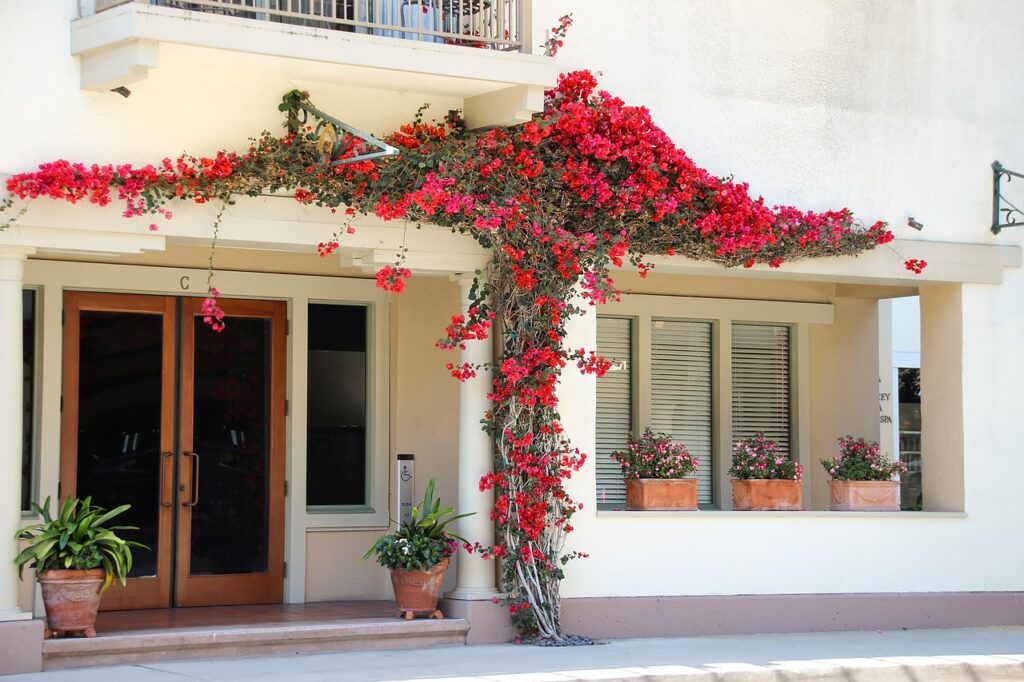
The showy bracts serve an important purpose for bougainvillea. They help attract pollinators like bees and butterflies to the true flowers concealed within. Once pollinated, the true flowers give way to small, inconspicuous fruit that contains tiny seeds.
Bougainvillea is perennial in mild climates, providing years of vibrant beauty to your garden. With proper care and maintenance, it can reach an impressive height of 15 to 30 feet and spread out over a similar distance, creating a sprawling and eye-catching display of color.
Bougainvillea Varieties: Dwarf, Semi-Dwarf, and Extra Large
Bougainvillea cultivars come in various sizes, allowing you to choose the perfect fit for your garden or landscape.
Dwarf Bougainvillea
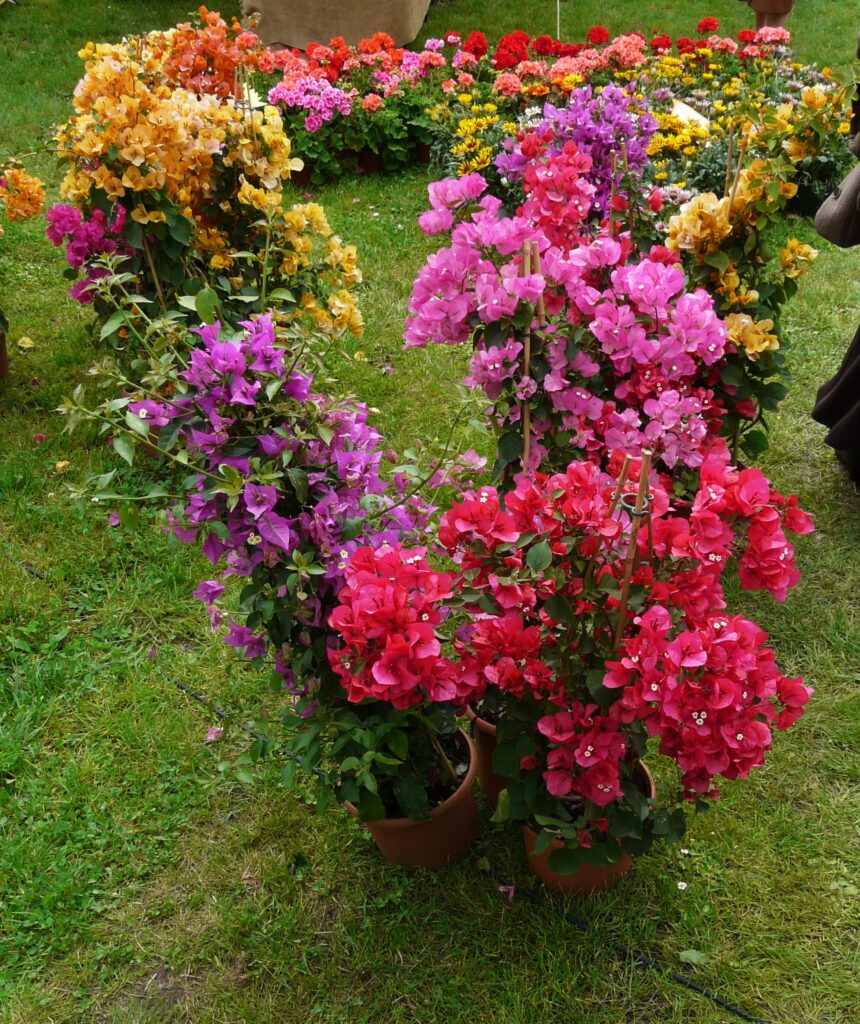
Dwarf bougainvillea varieties are compact and well-suited for smaller gardens, containers, or areas where space is limited. They offer all the beauty of bougainvillea in a more manageable size range.
Popular Dwarf Bougainvillea Cultivars
‘Helen Johnson’: This dwarf variety features stunning magenta-pink bracts and a compact growth habit. It reaches a height of 3 to 4 feet and is perfect for borders or small spaces.
‘La Jolla’: ‘La Jolla’ displays vibrant pink bracts and has a trailing habit, making it an excellent choice for hanging baskets or cascading over walls. It grows to a height of 2 to 3 feet.
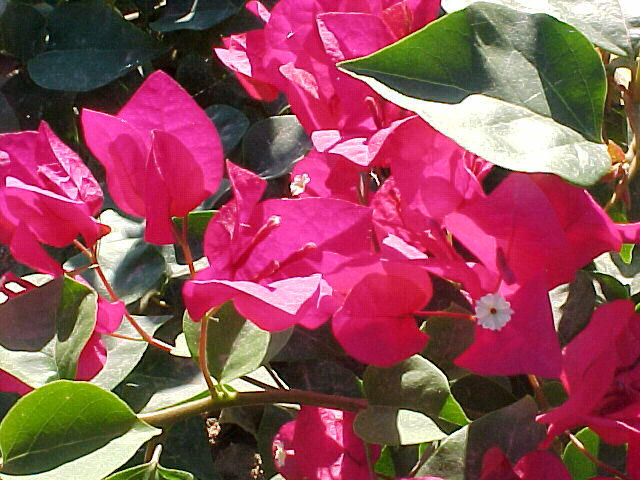
‘Pixie Queen’: With its variegated bracts in shades of pink and white, ‘Pixie Queen’ adds a touch of elegance to any garden. It has a bushy growth habit and reaches a height of 2 to 3 feet.
‘Vera Purple’: This dwarf cultivar boasts intense purple bracts and a compact, rounded growth habit. It is well-suited for borders or containers, growing up to 3 to 4 feet in height.
‘Tango’: ‘Tango’ offers vibrant orange bracts and a semi-dwarf growth habit. It is a prolific bloomer and reaches a height of 3 to 4 feet, making it an eye-catching addition to any landscape.
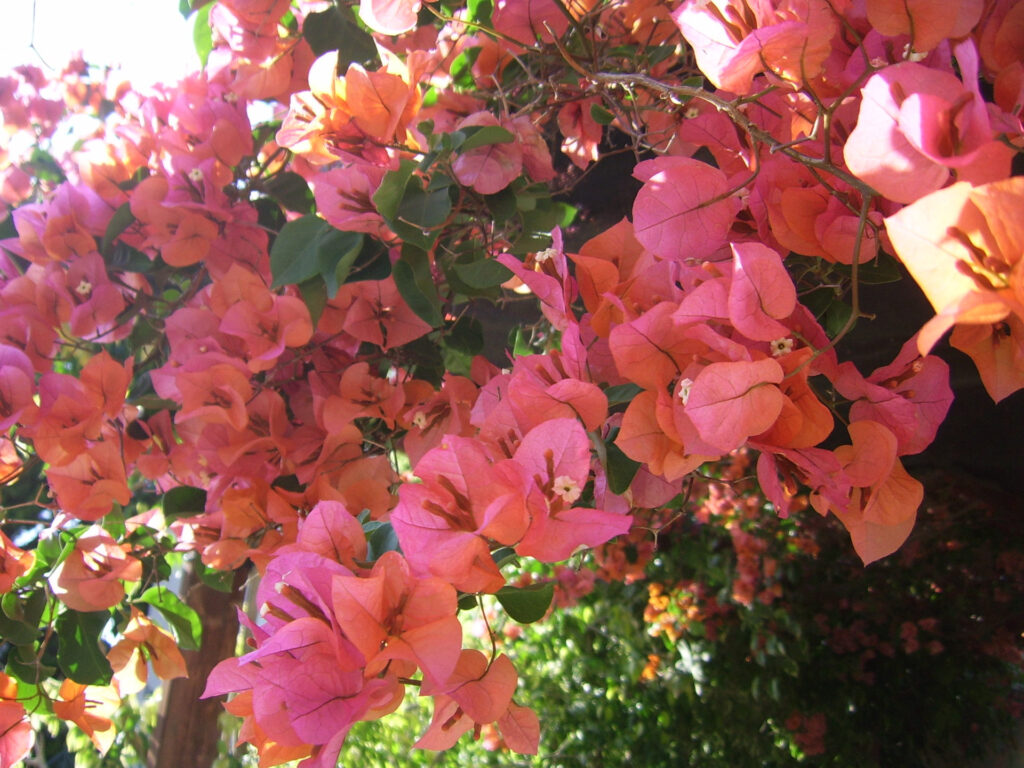
‘Singapore Pink’: This dwarf variety showcases delicate pink bracts and a low, spreading growth habit. It grows to a height of 2 to 3 feet, making it ideal for ground cover or rock gardens.
Semi-Dwarf Bougainvillea
Semi-dwarf bougainvillea varieties offer a balance between compact size and impressive floral displays. They are well-suited for hedges, trellises, or as standalone specimens.
Popular Semi-Dwarf Bougainvillea Cultivars
‘Torch Red’: With its vibrant red bracts, ‘Torch Red’ adds a fiery splash of color to the garden. It has a semi-dwarf growth habit, reaching a height of 4 to 6 feet, and is perfect for accentuating fences or arbors.
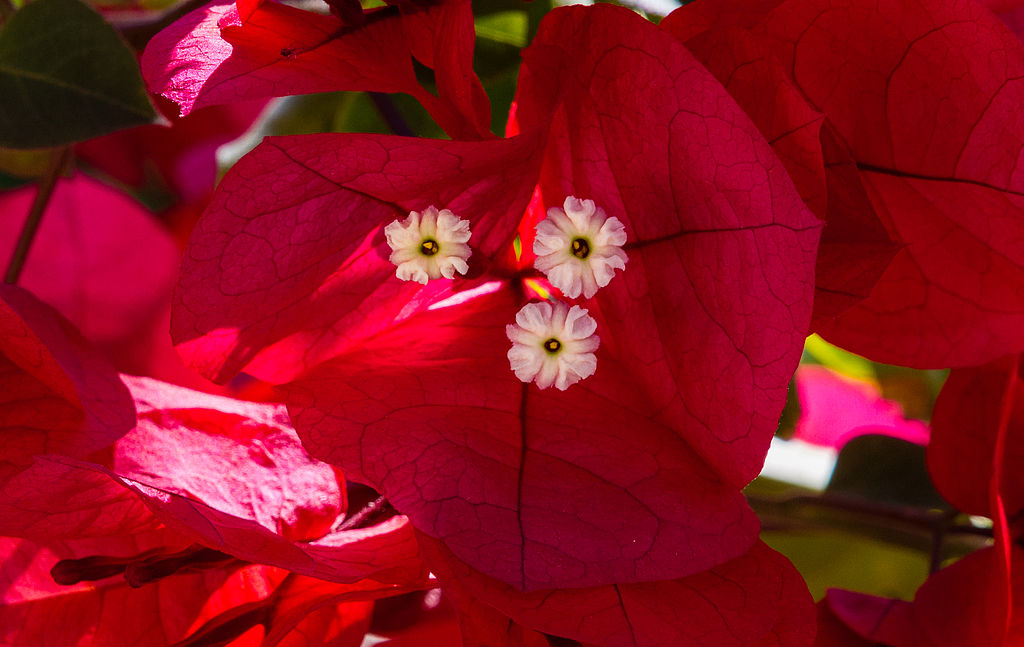
‘Double Gold’: This semi-dwarf cultivar features double-layered bracts in a dazzling golden-yellow hue. It has a bushy growth habit and grows to a height of 4 to 5 feet.
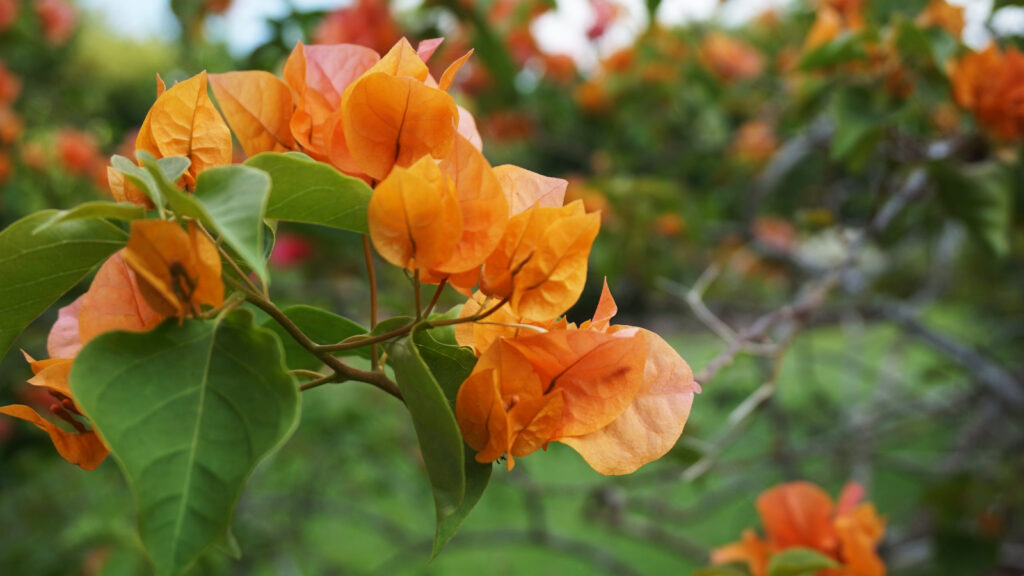
‘Raspberry Ice’: ‘Raspberry Ice’ displays striking raspberry-pink bracts with white accents. It has a semi-dwarf growth habit and reaches a height of 4 to 5 feet, making it a standout choice for borders or containers.
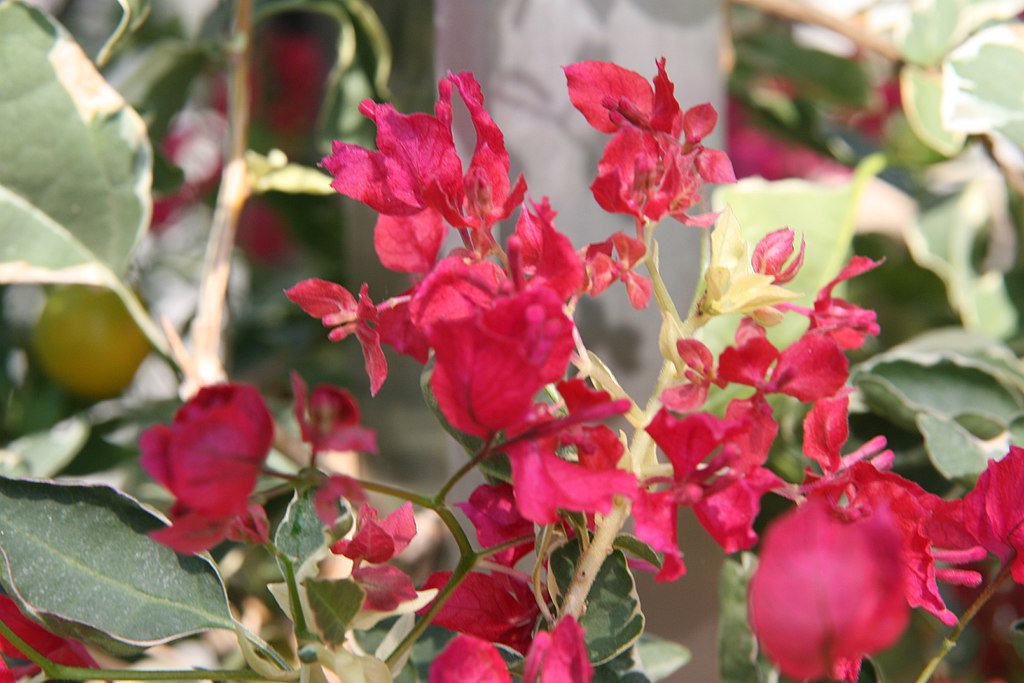
‘California Gold’: With its brilliant golden-yellow bracts, ‘California Gold’ adds a touch of warmth to the garden. It has a semi-dwarf growth habit, growing up to 4 to 6 feet in height.
‘Sundown Orange’: This semi-dwarf variety showcases vibrant orange bracts and a compact growth habit. It reaches a height of 4 to 5 feet, making it an attractive choice for landscaping or container planting.
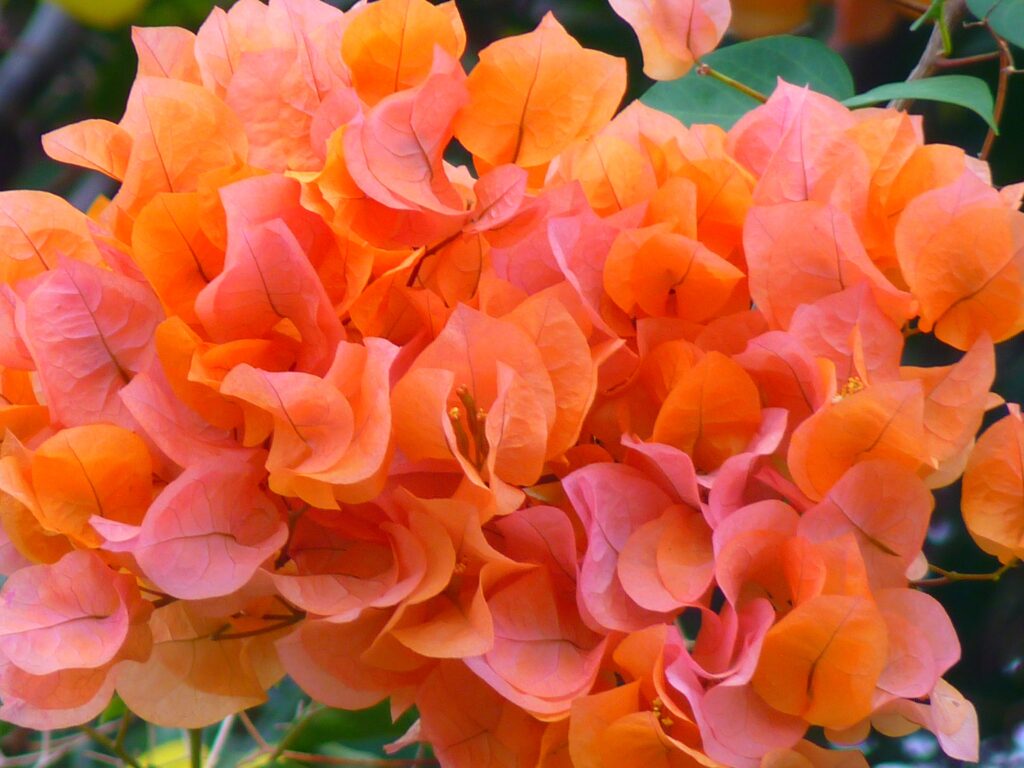
‘Double Pink’: ‘Double Pink’ offers beautiful double-layered pink bracts and a semi-dwarf growth habit. It grows to a height of 4 to 6 feet and is a charming addition to any garden or patio.
Extra Large Bougainvillea
Extra large bougainvillea varieties make a bold statement in the landscape with their impressive size and profusion of colorful bracts. They are ideal for creating focal points or providing maximum coverage.
Popular Extra Large Bougainvillea Cultivars
‘Spectabilis’: ‘Spectabilis’ showcases stunning magenta bracts and has a vigorous climbing habit. It can reach a towering height of 20 to 30 feet, adding a dramatic touch to arbors or pergolas.
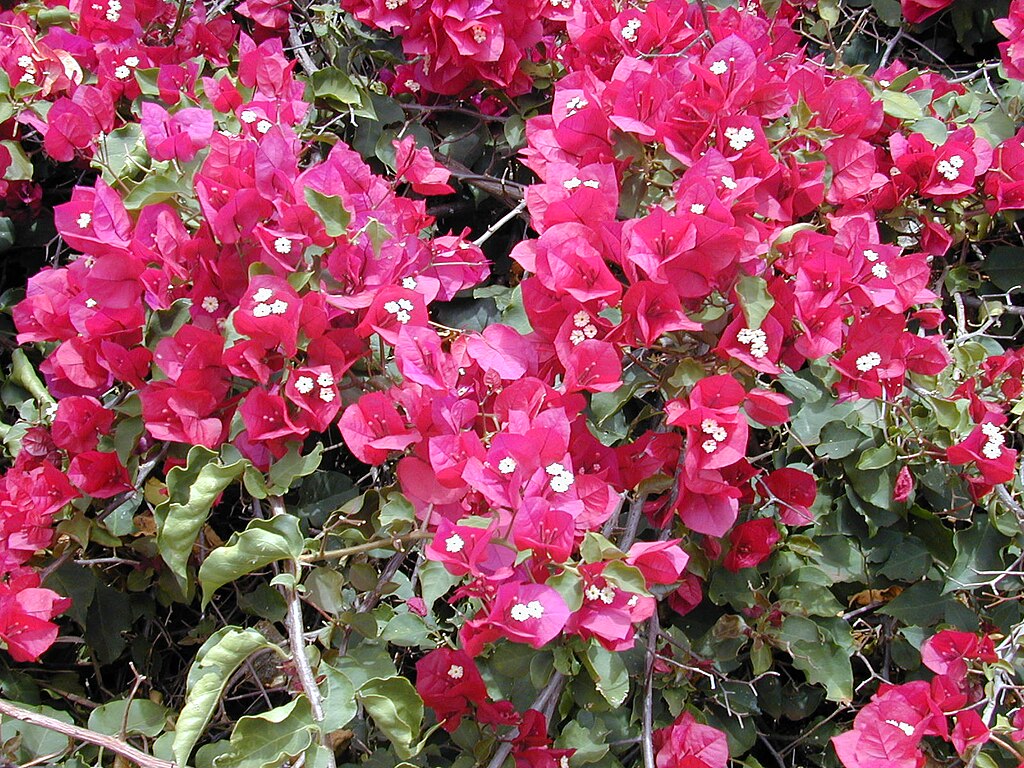
‘San Diego Red’: This extra large variety features brilliant red bracts and a sprawling growth habit. It can reach a height and spread of 15 to 25 feet, creating a breathtaking display in the landscape.
‘Purple Queen’: ‘Purple Queen’ offers vibrant purple bracts and a climbing habit. It can grow up to 20 to 30 feet in height, making it a striking choice for trellises or fences.
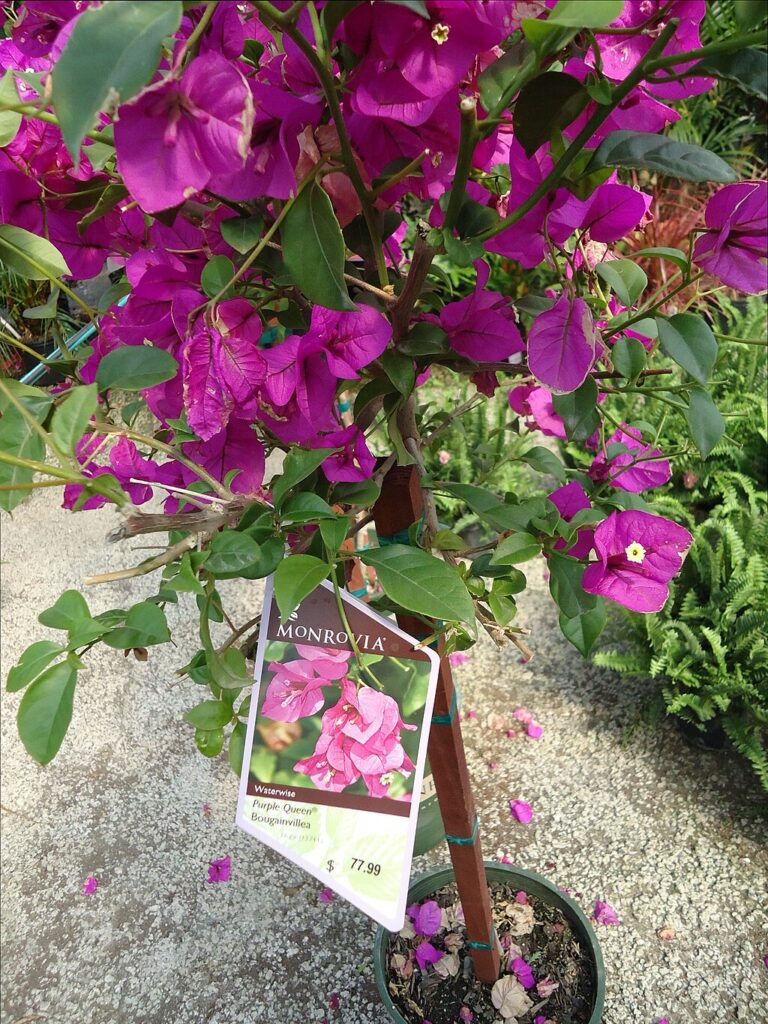
‘Royal Purple’: With its rich purple bracts, ‘Royal Purple’ adds regal beauty to any garden. It has a vigorous climbing habit and can reach a height of 20 to 30 feet.
‘Miss Alice’: This extra large cultivar displays pure white bracts and a sprawling growth habit. It can grow up to 15 to 25 feet in height and spread, creating a stunning display against dark green foliage.
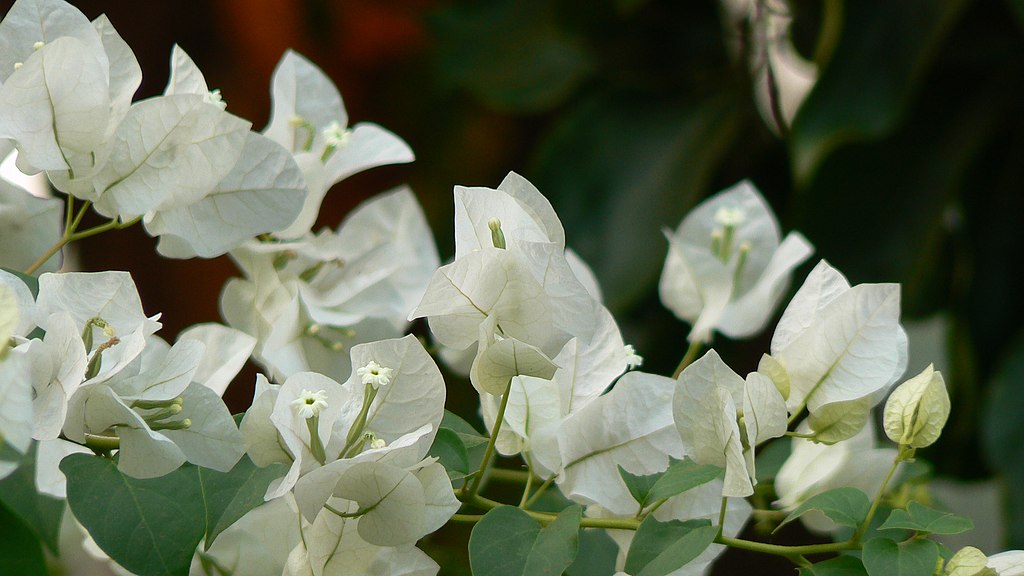
‘Rosenka’: ‘Rosenka’ offers unique apricot-colored bracts and a climbing habit. It can reach a height and spread of 20 to 30 feet, adding a warm and inviting touch to trellises or walls.
Ideal Growing Conditions for Bougainvillea
Bougainvillea thrives in hot and humid subtropical climates, making it an ideal choice for gardeners in the southern regions of the United States. It flourishes in regions with warm summers and mild winters, where temperatures rarely drop below freezing.
It is most commonly grown in USDA Hardiness Zones 9 through 11, encompassing areas such as the Gulf Coast, Southern Florida, and parts of California and Arizona.
To ensure the successful growth and blooming of your bougainvillea, it’s crucial to provide it with the optimal growing conditions. Here are the key factors to consider:
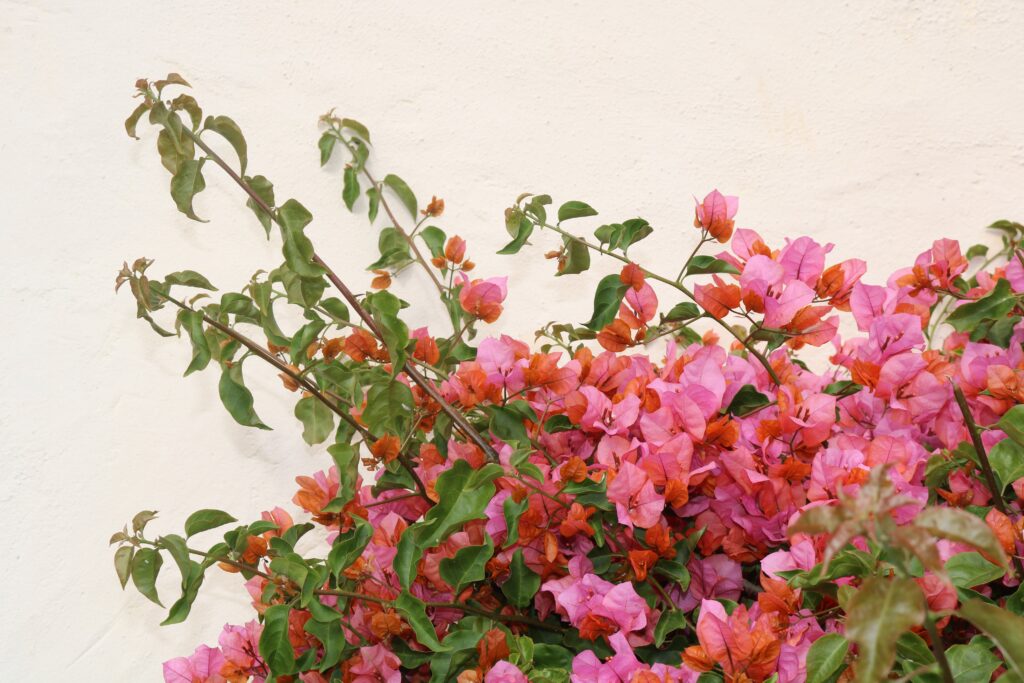
Type of Climate Required
Temperature
Bougainvillea thrives in temperatures between 60°F (15°C) and 90°F (32°C), with temperatures around 70°F to 85°F (21°C to 29°C) being ideal for growth and blooming.
It is important to protect the plant from freezing temperatures, as they can damage or kill it. If you live in an area prone to frost, consider growing bougainvillea in containers that can be moved indoors during colder months.
Temperature Tolerance
When temperatures consistently drop below 50°F (10°C), bougainvillea’s growth may slow down or temporarily cease. However, it can resume growth when warmer conditions return.
Temperatures below 32°F can cause damage to bougainvillea. Prolonged exposure to freezing temperatures can result in wilting, leaf discoloration, leaf drop, and damage to the stems and branches. In severe cases, it can lead to plant death.
Bougainvillea can tolerate high temperatures, but extreme heat, especially above 100°F, can stress the plant. It may result in wilting, scorched leaves, reduced blooming, and overall decline. Providing shade or ensuring adequate hydration during hot spells can help mitigate the effects of excessive heat.
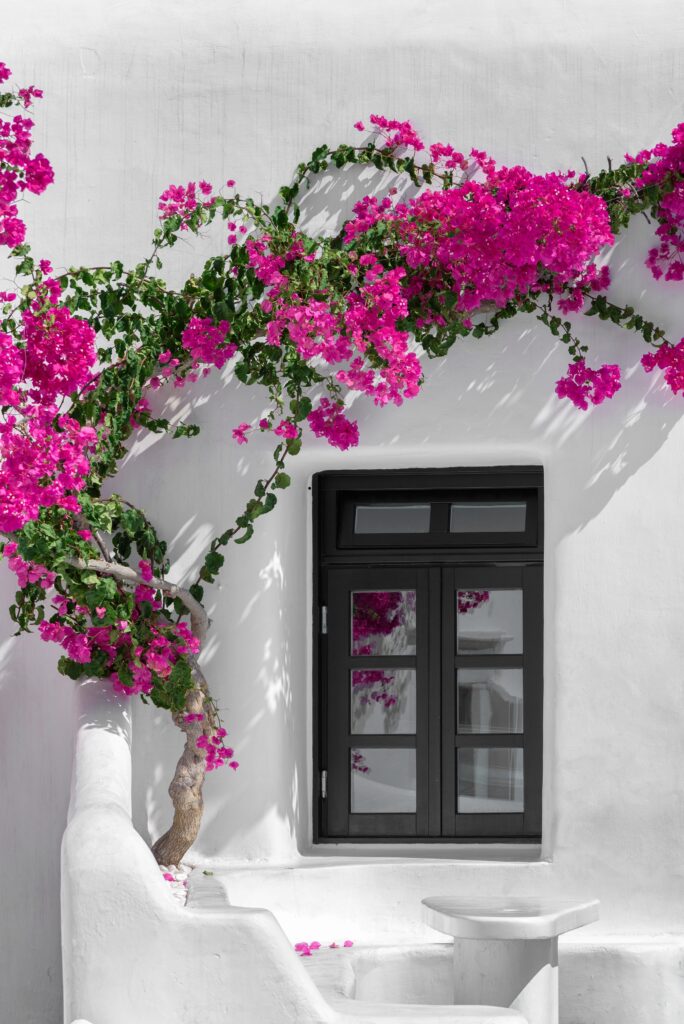
Humidity
Bougainvillea appreciates moderate to high humidity levels, which are typically found in subtropical regions.
If you live in a drier climate, you can increase humidity around the plant by misting it regularly or placing a tray filled with water near the plant to create a humid microclimate.
Sunlight Exposure
Bougainvillea thrives in full sunlight. It requires at least 6 to 8 hours of direct sunlight each day to produce an abundance of colorful bracts. Choose a location in your garden that receives ample sunlight and is not shaded by trees or buildings.
Ensure you plant bougainvillea in a location with maximum exposure to sunlight.
Soil Type
Bougainvillea prefers well-draining soil that is rich in organic matter. Sandy loam or loamy soil is ideal for bougainvillea cultivation. If your soil is heavy or clay-like, consider improving its drainage and fertility by adding compost or well-rotted manure.
Bougainvillea thrives in slightly acidic to neutral soil with a pH range of 6.0 to 7.0. Conduct a soil test to determine the pH of your garden soil. If the pH is outside the preferred range, adjust it by adding amendments.
For increasing acidity, use elemental sulfur, and for increasing alkalinity, add dolomite lime.
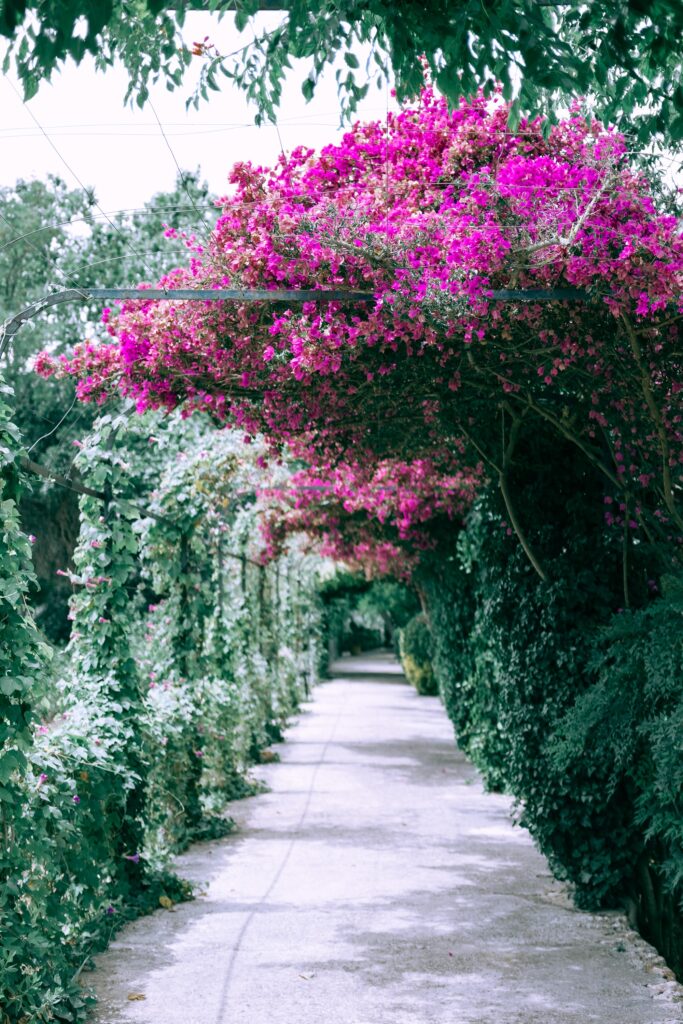
When and How to Plant Bougainvillea
The best time to plant bougainvillea in the ground is during the warm months of spring or early summer when the soil has warmed up and all danger of frost has passed. This allows the plant to establish its roots before the colder months arrive.
However, if you live in a region with mild winters, planting can also be done in fall.
Planting Bougainvillea Step-by-Step
When you’re ready to plant your bougainvillea, follow these steps:
Find a Good Location
Choose a location in your garden that receives full sunlight and has well-draining soil. Ensure there is enough space for the bougainvillea to grow and spread comfortably.
Prepare the Soil
Amend the soil by incorporating organic matter such as compost or well-rotted manure. This helps improve soil fertility, drainage, and water-holding capacity. Remove any weeds or debris from the planting area.
Dig the Planting Hole
Dig a hole that is twice as wide and deep as the bougainvillea’s root ball. This allows the roots to spread out easily. Ensure the hole is deep enough to accommodate the entire root system without bending or crowding.
Remove the Plant from its Container
Gently tap the sides of the container to loosen the root ball. Carefully slide the plant out, holding it by the base of the stems.
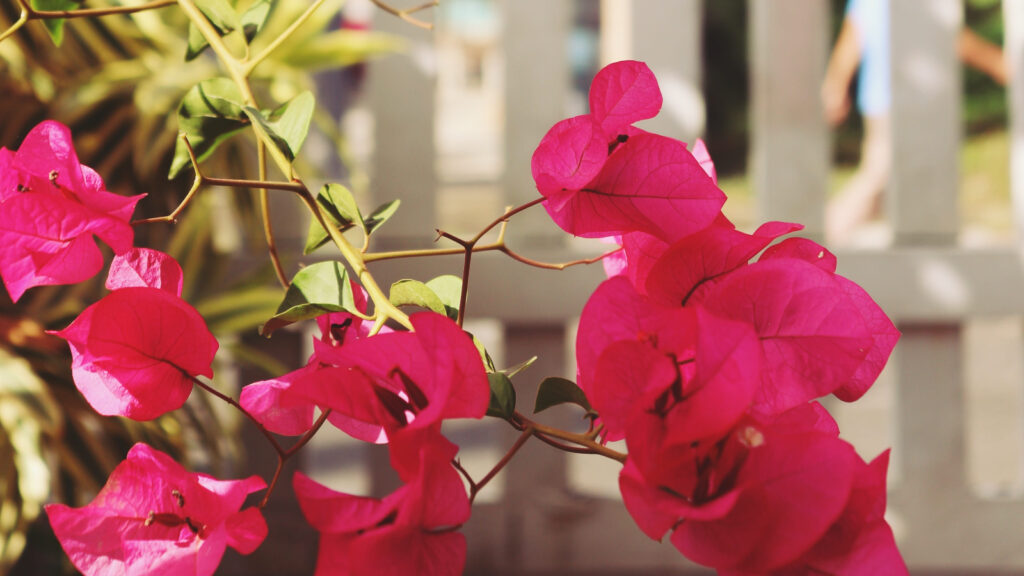
Planting the Bougainvillea
Place the root ball in the center of the planting hole, ensuring the top of the root ball is level with or slightly above the soil surface.
Backfill the hole with soil, firming it gently around the roots to eliminate air pockets.
Watering and Mulching
After planting, thoroughly water the bougainvillea to settle the soil and encourage root establishment.
Apply a layer of organic mulch, such as wood chips or straw, around the base of the plant, leaving a small gap around the stems to prevent rotting.
Care and Maintenance of Bougainvillea
Once you’ve planted your bougainvillea, you’ll want to make sure it thrives.
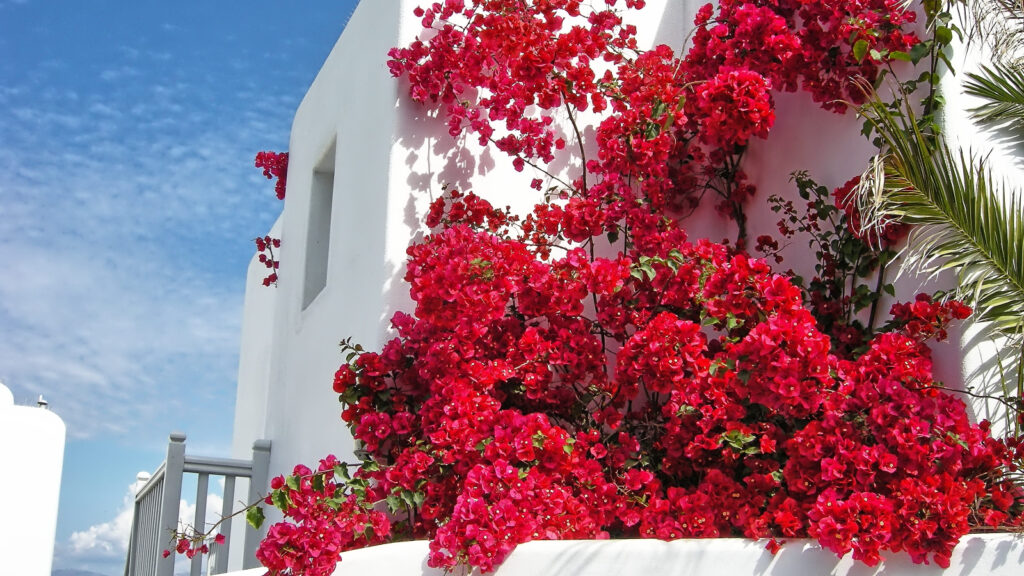
Watering Throughout the Year
During the active growing seasons of spring and summer, water bougainvillea deeply and thoroughly, allowing the soil to dry out slightly between waterings. Aim to provide regular, consistent moisture without waterlogging the roots.
Reduce watering frequency during the dormant period around late fall through the winter. Water sparingly, allowing the soil to dry out more between waterings.
However, ensure the plant doesn’t experience prolonged drought stress, especially as temperatures begin to rise in February.
Optimal Fertilizer Composition and Schedule:
Fertilize your bougainvillea according to its stage of development and the needs of the season.
Spring
Use a balanced fertilizer with equal NPK (nitrogen, phosphorus, potassium) ratios or a slightly higher nitrogen content.
Apply the fertilizer every 4 to 6 weeks during the active growing season.
Summer
Switch to a bloom-boosting fertilizer with a higher phosphorus content to promote abundant flowering. Apply every 6 to 8 weeks.
Fall and Winter
Reduce or suspend fertilization during the dormant period. Bougainvillea generally requires less fertilizer during this time.
Follow the instructions on the fertilizer package for specific application rates and guidelines. Then, adjust fertilization based on the plant’s response and the quality of your soil.
Protecting Bougainvillea from Cold
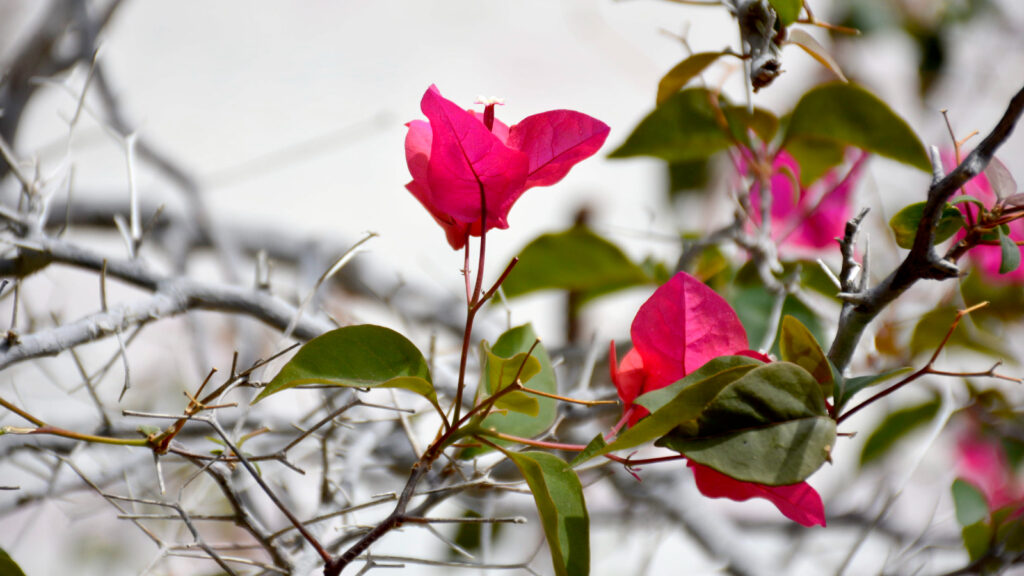
Even though we can grow tropical plants, we can still get the occasional cold snap in Florida and in states around the Gulf Coast.
Our normally mild winters can even mean that a cold snap is that much more devastating to plants that aren’t equipped to deal with them.
How you protect your bougainvillea will vary depending on how long the cold snap is predicted to last.
Watering
If you’ve lived in Florida for any length of time, you know how insane our weather can be. In the winter, for example, the temperature during the day could be 85°F and then sink to 38°F during the night, usually with the lowest temperature right before sunrise.
This happens several times a year in Central Florida, sometimes in December, but usually in January and February.
If the forecast is for a brief overnight cold snap, you should water your bougainvillea well during the warmth of the day prior.
The moist ground will store the warmth of the sun during the day, carrying through the night. So, make sure you water as early as possible to make the most of the sunlight.
If the cold period is predicted to last through daylight hours or last for several nights, excess moisture in the soil is a bad thing. So, in that case, do not water your bougainvillea during cold days or when it will be below 40°F for several nights in a row.
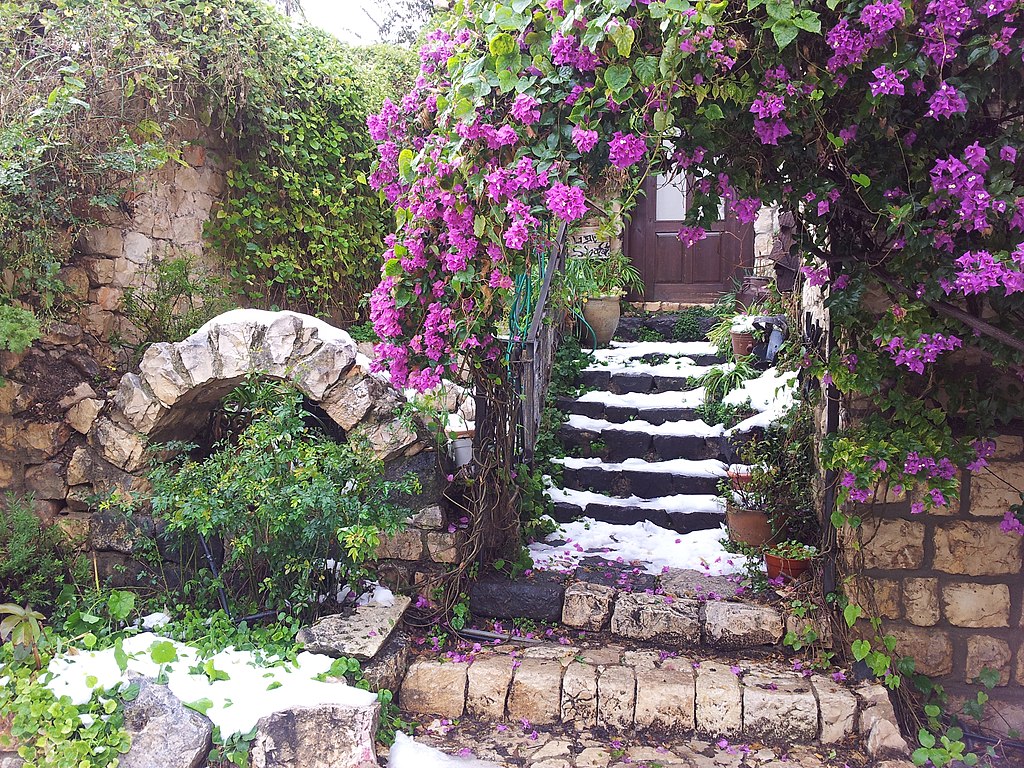
Mulching
Whether your water or not, it’s a good idea to apply a thick layer of organic mulch around the base of the plant, extending it to cover the root zone. This helps insulate the soil and protect the roots from extreme cold.
Covering
Before the arrival of frost or freezing temperatures, cover the bougainvillea plant with a frost blanket or horticultural fabric. Secure the cover to the ground to create a protective barrier against cold winds.
I generally try to cover my plants well before sunset and the warmth of the day fade.
Container Plants
If you have bougainvillea in containers, move them to a sheltered location, such as a garage or greenhouse, during periods of freezing temperatures.
Pruning Bougainvillea for Optimal Growth and Shape
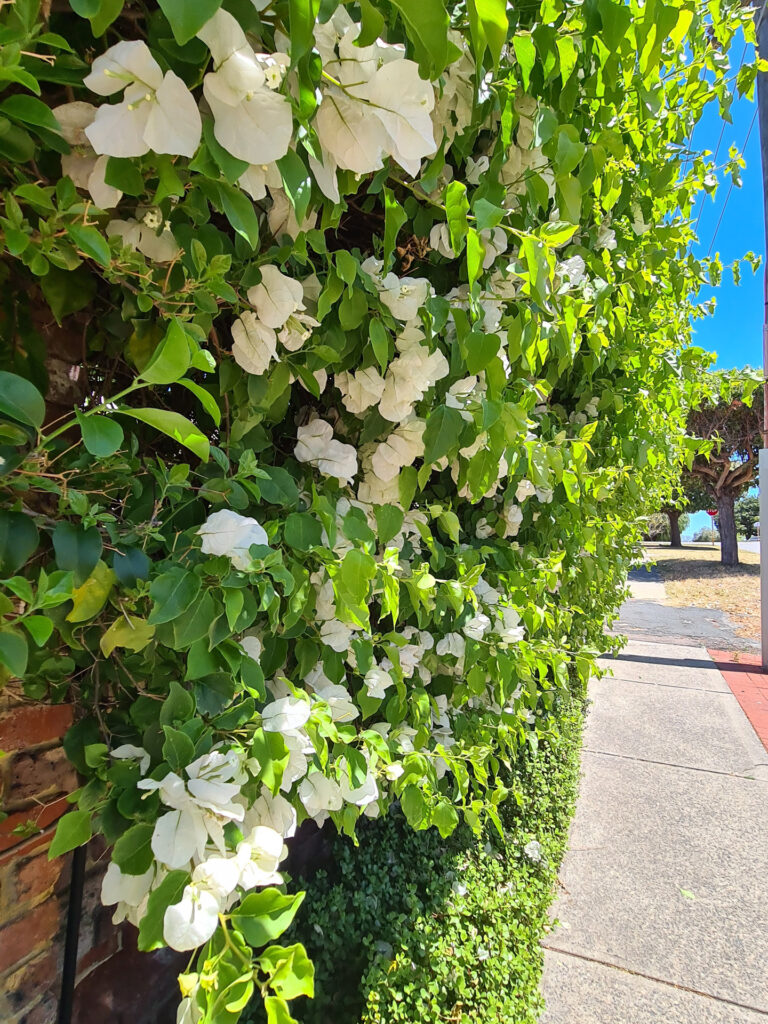
Pruning bougainvillea is essential for maintaining its shape, encouraging healthy growth, and promoting abundant flowering. Here’s a guide on how and when to prune your bougainvillea:
Timing of Pruning:
The best time to prune bougainvillea is during late winter or early spring, just before new growth begins. This timing allows the plant to recover and produce new shoots and blooms during the active growing season. However, minor pruning to remove dead or damaged branches can be done throughout the year. You may also need to prune it to keep it under control.
Tools Needed:
- Pruning shears or sharp bypass hand pruners
- Gardening gloves
- Loppers or a pruning saw for thicker branches (if necessary)
- Disinfectant solution (such as rubbing alcohol or bleach) to sterilize your pruning tools (before and after use) to prevent the spread of diseases.
The Pruning Process
Pruning bougainvillea while avoiding the thorns.
Follow these steps to prune your bougainvillea effectively:
Step 1: Assess the Plant:
Observe your bougainvillea and identify the branches that need to be pruned. Look for dead, damaged, or diseased branches, as well as any overly long or unruly growth that needs shaping.
Step 2: Prepare Your Tools:
Ensure your pruning tools are clean and sharp. Sterilize them with a disinfectant solution to prevent the spread of diseases from one plant to another.
Step 3: Prune Dead or Damaged Branches:
Start by removing any dead, damaged, or diseased branches. Make clean cuts just above a healthy bud or side branch, using sharp pruning shears. Cut at a slight angle to allow water to drain off the wound.
Step 4: Control the Plant’s Size and Shape:
To maintain the desired size and shape of your bougainvillea, selectively prune long or unruly branches. Identify branches that are extending beyond the desired boundaries or obstructing walkways, fences, or structures. Make pruning cuts just above a bud or side branch, leaving a stub of the branch to promote new growth.
Step 5: Thinning Out the Canopy (Optional)
If your bougainvillea is dense and overcrowded, you may consider thinning out the canopy to improve airflow and light penetration. Remove some of the interior branches to open up the plant and reduce the risk of pests or diseases.
Step 6: Clean Up and Disinfect:
After pruning, gather and remove the pruned branches and debris from the area. Dispose of them properly. Clean and disinfect your pruning tools with a sterilizing solution to prevent the spread of diseases.
Step 7: Post-Pruning Care:
After pruning, water your bougainvillea thoroughly to help it recover and encourage new growth. Apply a balanced fertilizer to provide the necessary nutrients for the plant’s recovery.
Remember, bougainvillea blooms on new growth, so avoid excessive pruning that removes too many potential blooming branches. Pruning should focus on maintaining the plant’s shape, removing dead or damaged branches, and promoting healthy growth.
Propagating Bouganvillea Cheap and Easy
The method works for me, so thanks to David the Good for this video.
Common Pests, Diseases, and Special Care for Bougainvillea
Bougainvillea, like any other plant, can be susceptible to certain pests, diseases, and specific care requirements. Here’s a breakdown of common pests, diseases, and special care for bougainvillea:
Common Bougainvillea Pests
Aphids
Aphids are small, soft-bodied insects that feed on plant sap, causing leaves to curl, yellow, or become distorted. To remedy aphid infestations, you can:
Spray a strong stream of water on the affected plant parts to dislodge the aphids.
Apply insecticidal soap or horticultural oil following the product instructions.
Introduce natural predators like ladybugs or lacewings to control aphid populations.
Caterpillars
Caterpillars, such as the bougainvillea looper or cabbage looper, can chew on leaves, causing significant damage. To remedy caterpillar infestations, you can:
Handpick and remove caterpillars from the plant.
Apply Bacillus thuringiensis (Bt), a biological insecticide that targets caterpillars.
Use insecticidal sprays labeled for caterpillar control, following the product instructions.
Whiteflies
Whiteflies are tiny, sap-sucking insects that cluster on the undersides of leaves, causing yellowing, leaf drop, and a sticky residue called honeydew. To remedy whitefly infestations, you can:
Use yellow sticky traps to capture adult whiteflies.
Spray the affected foliage with insecticidal soap or horticultural oil, ensuring thorough coverage.
Encourage natural predators like parasitic wasps or ladybugs to control whitefly populations.
Common Bougainvillea Diseases
Leaf Spot
Leaf spot diseases, caused by fungi, manifest as dark spots or lesions on the foliage. To remedy leaf spot diseases, you can:
Prune and remove affected plant parts to improve airflow and reduce disease spread.
Apply copper-based fungicides according to the product instructions.
Powdery Mildew
Powdery mildew appears as a white, powdery coating on leaves, stems, and flowers. To remedy powdery mildew, you can:
Prune and thin out the plant to improve airflow.
Apply fungicides labeled for powdery mildew control, following the product instructions.
Root Rot
Root rot is a fungal disease caused by overly wet or poorly draining soil. It leads to root decay, wilting, and overall decline of the plant. To remedy root rot, you can:
Improve soil drainage by amending the soil with organic matter.
Adjust watering practices to avoid waterlogging the roots.
Apply fungicides labeled for root rot control, following the product instructions.
Special Needs and Care for Bougainvillea
Pruning and Training
Regular pruning is essential for maintaining shape, promoting airflow, and removing dead or diseased branches. Train bougainvillea to climb or grow in a desired direction using trellises, fences, or stakes.
Support for Climbing Varieties
If you have climbing varieties, provide proper support structures like trellises, arbors, or wires to guide the vines and prevent damage to nearby structures.
Winter Protection in Colder Zones
In regions with colder winters, protect bougainvillea from freezing temperatures by covering with frost blankets, moving potted plants indoors, or providing a sheltered location.
Landscape Design Ideas and Companion Plants for Bougainvillea
Bougainvillea’s vibrant colors and sprawling growth make it a fantastic addition to any landscape design in subtropical regions. Here are some design ideas and appropriate companion plants to complement bougainvillea.
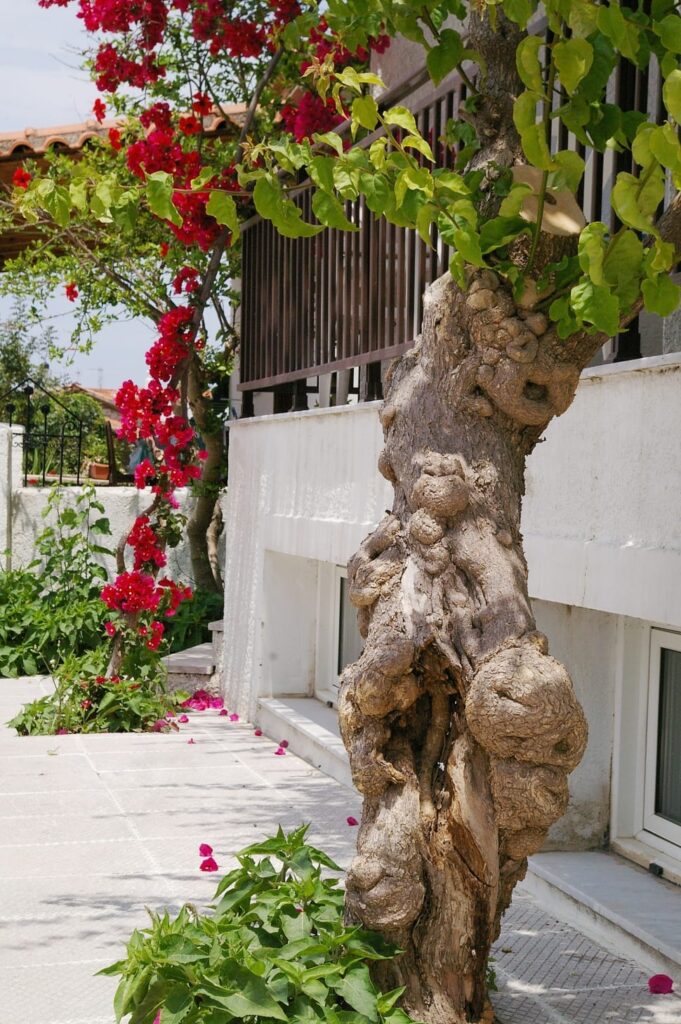
Design Ideas Using Bougainvillea:
Colorful Fences and Walls
Use bougainvillea to add a splash of color and create a living tapestry along fences or walls. The vibrant bracts will create an eye-catching display and provide a beautiful backdrop for your outdoor space.
Pergolas and Trellises
Train bougainvillea vines to climb and adorn pergolas, trellises, or arbors. The cascading bracts will create a stunning overhead canopy, providing shade and a vibrant atmosphere.
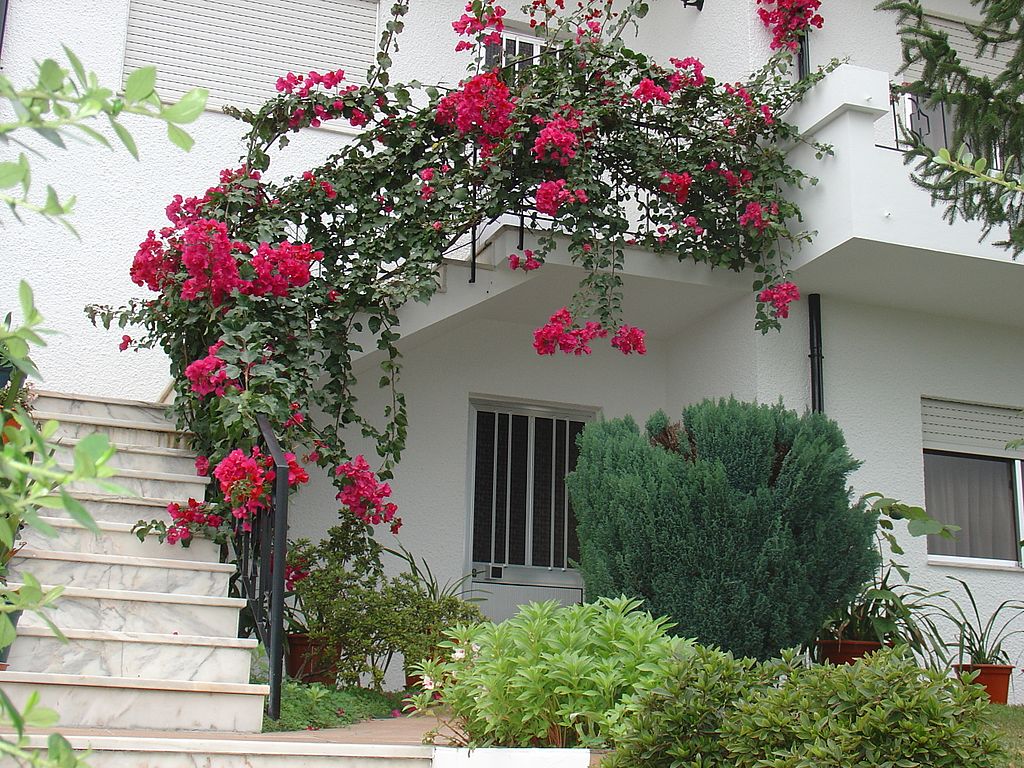
Container Planting
Plant bougainvillea in large containers or pots to add a vibrant focal point to patios, balconies, or entryways. Choose compact or dwarf varieties to keep the plant size manageable and ensure it thrives in the container environment.
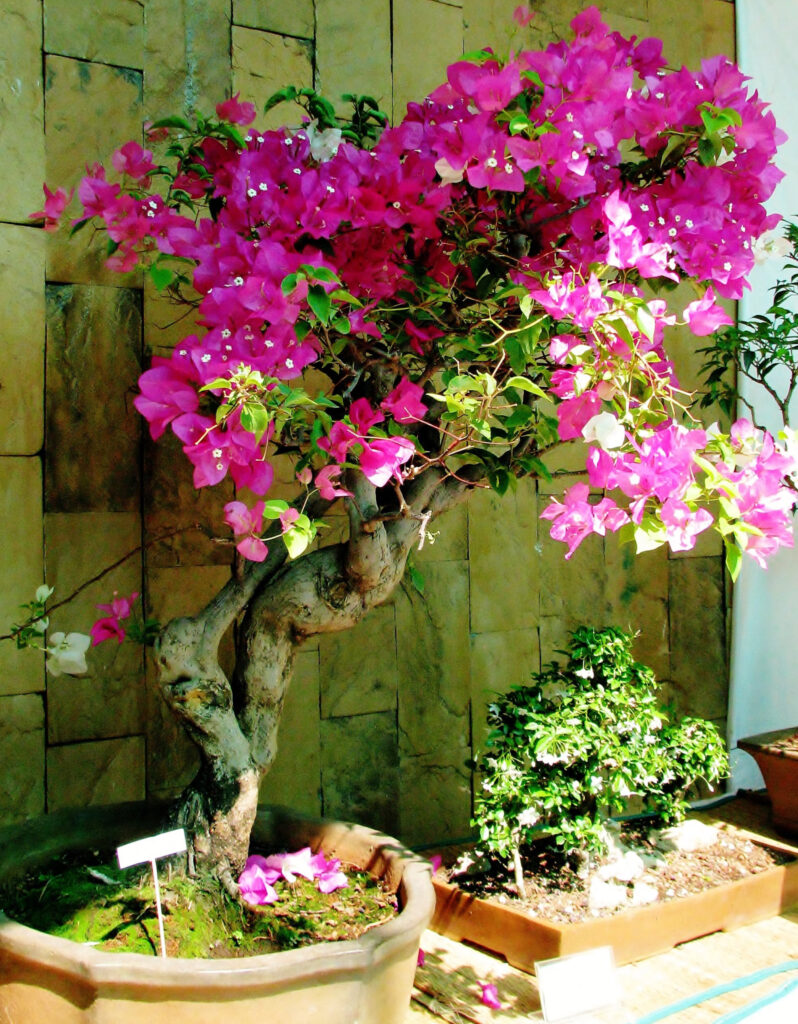
Courtyard Gardens
Create a Mediterranean-inspired oasis in your courtyard by incorporating bougainvillea. Use it as a backdrop for a tranquil seating area or plant it in containers for a burst of color amidst lush greenery.
Hedge or Border Planting
For privacy or to define garden boundaries, consider planting bougainvillea as a hedge or border. Prune it regularly to maintain a desired height and shape while enjoying its colorful display.
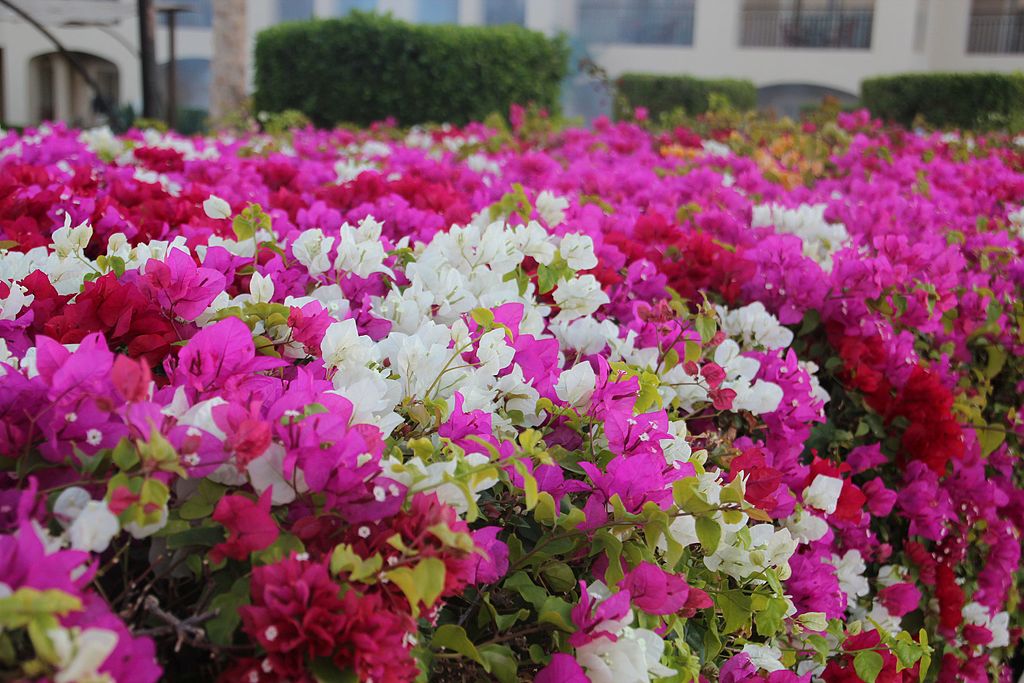
Companion Plants for Bougainvillea
Plumbago (Plumbago auriculata):
Plumbago’s delicate blue flowers provide a lovely contrast to the bold colors of bougainvillea. It is a versatile shrub that can be used as a low hedge or ground cover, adding depth and texture to the garden.
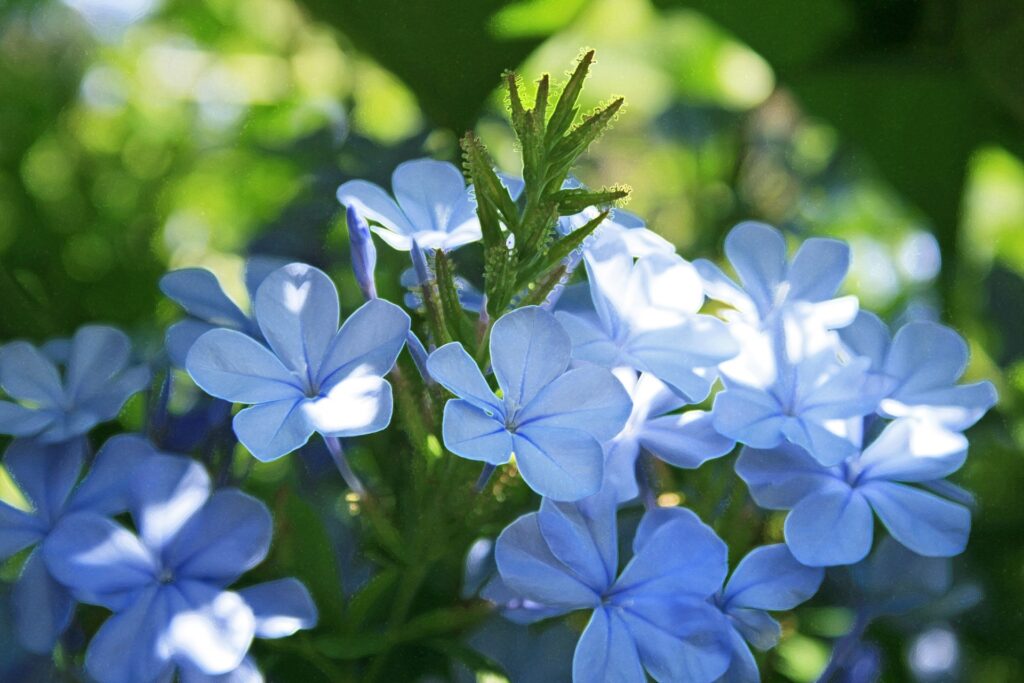
Mexican Flame Vine (Senecio confusus):
With its cascading orange or red flowers, Mexican Flame Vine creates a stunning combination when paired with bougainvillea. Allow it to climb or trail through the bougainvillea for a captivating display.
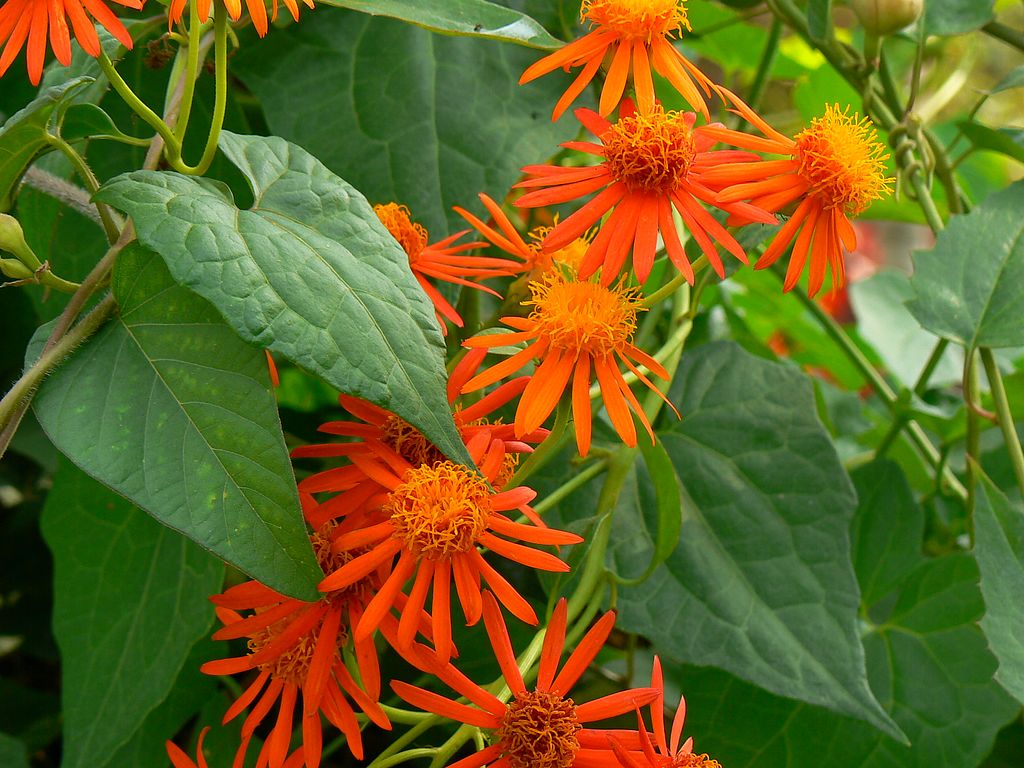
Dwarf Bottlebrush (Callistemon spp.):
Dwarf bottlebrush is known for its vibrant, brush-like flowers in shades of red, pink, or yellow. Planted alongside bougainvillea, it adds height variation and attracts pollinators to the garden.
Hibiscus (Hibiscus rosa-sinensis):
Hibiscus and bougainvillea together create a tropical paradise. The large, showy flowers of hibiscus complement the bracts of bougainvillea, enhancing the overall visual impact of the landscape.
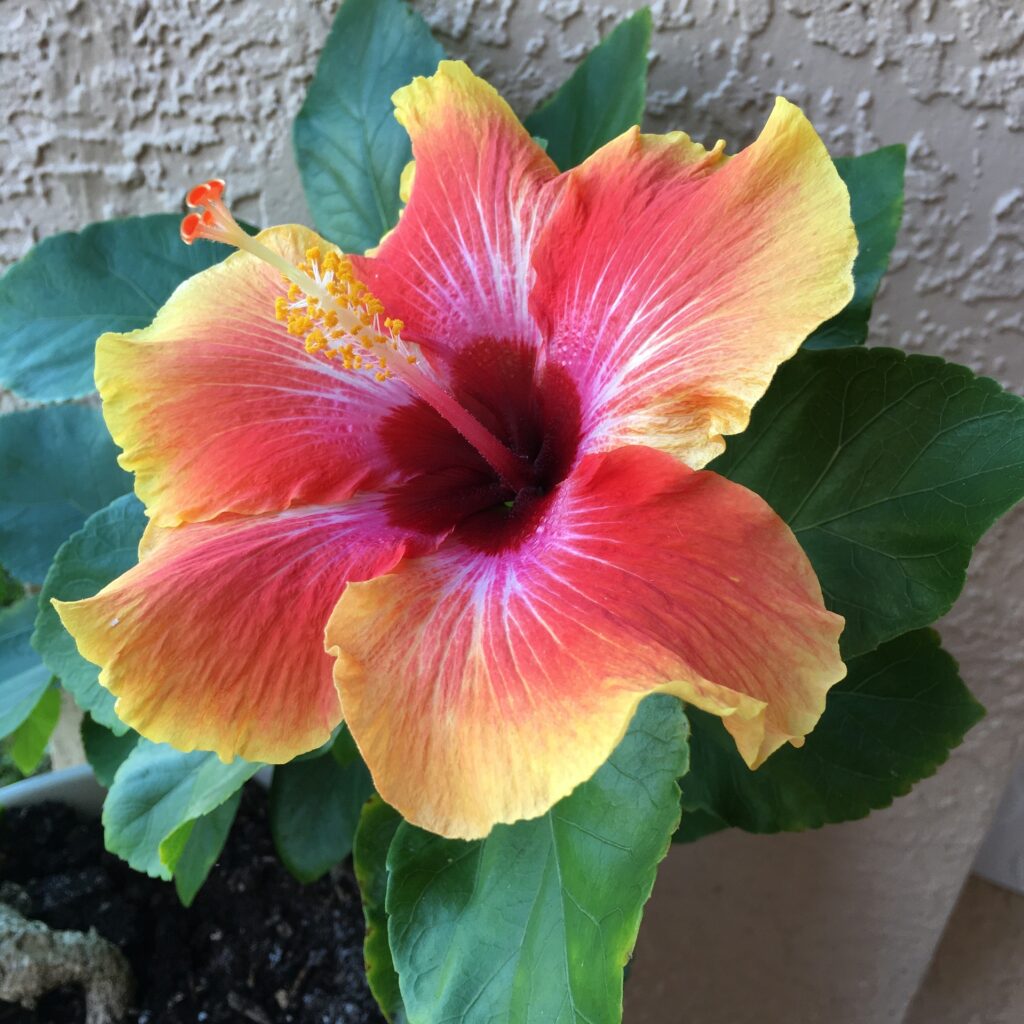
Bush Morning Glory (Convolvulus cneorum):
With its silver foliage and delicate white flowers, bush morning glory offers a beautiful contrast to the vibrant bracts of bougainvillea. Plant it as a low-growing ground cover or in containers.
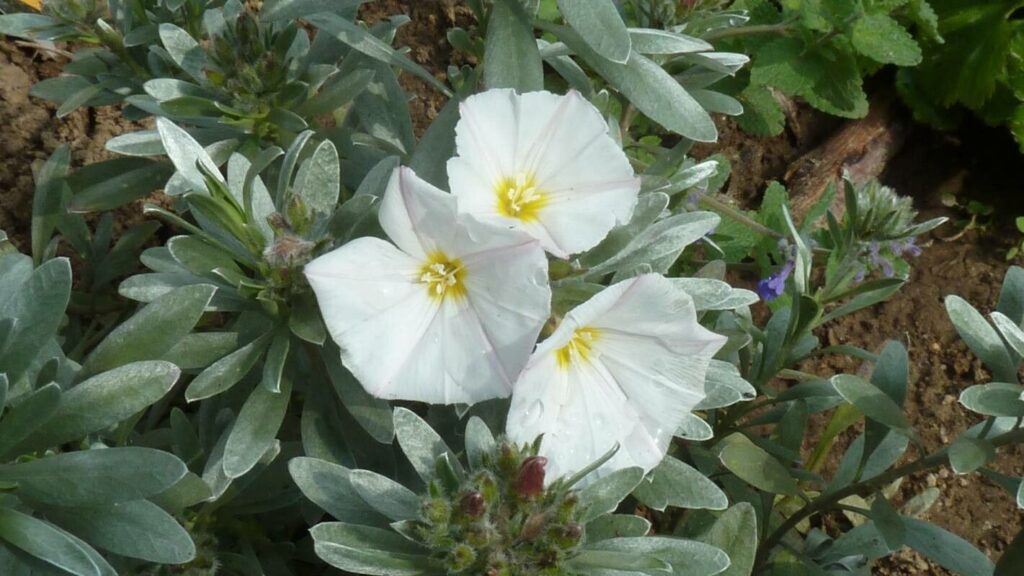
When selecting companion plants for bougainvillea, consider their sunlight, water, and soil requirements to ensure they are compatible. Aim for a harmonious combination that enhances the visual appeal and complements the colors and textures of bougainvillea.
Bougainvillea can be incorporated into various landscape designs, from vibrant walls and fences to container plantings and courtyards. Pairing it with appropriate companion plants adds depth and creates a visually stunning garden.
The Beauty and Versatility of Bougainvillea in Your Garden
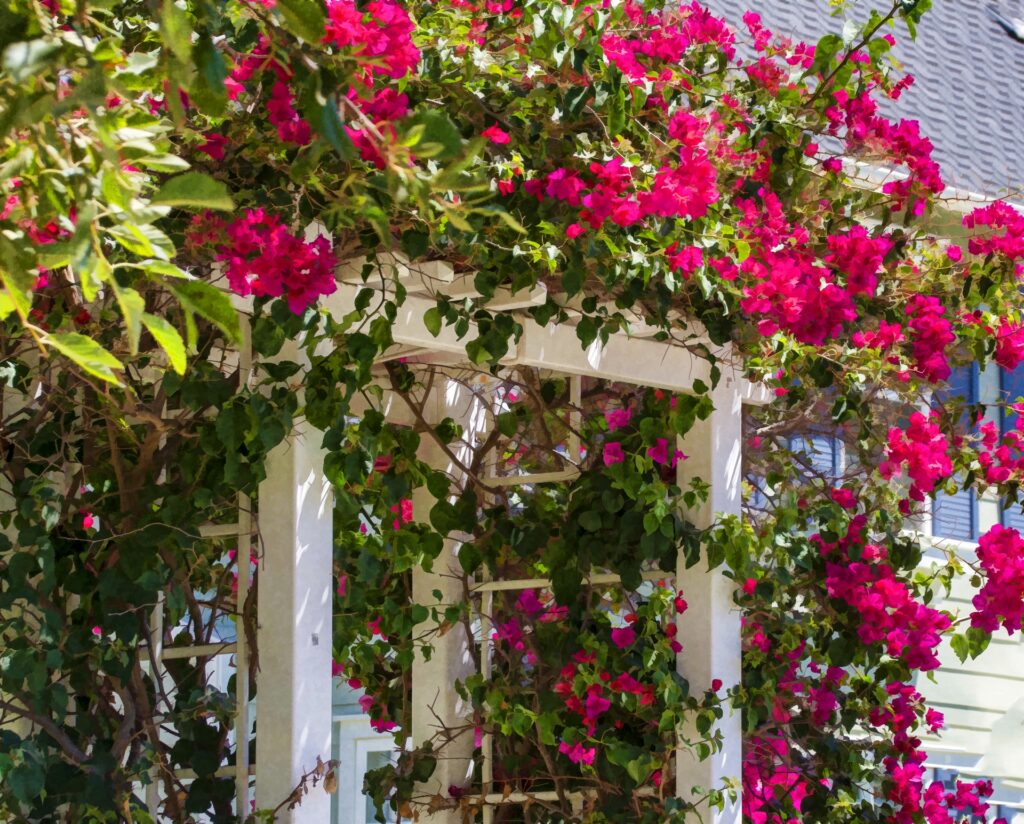
Bougainvillea, with its vibrant and abundant display of colorful bracts, is a true gem for subtropical gardens in USDA Zones 9 to 11. Its versatility, resilience, and stunning visual appeal make it a cherished addition to any landscape design. Bougainvillea’s ability to thrive in hot and humid climates, coupled with its preference for full sunlight, allows it to create a striking visual impact on walls, fences, trellises, and in containers. Whether used as a focal point, a living tapestry, or a cascading canopy, bougainvillea adds a touch of tropical beauty and splendor to outdoor spaces. With proper care, pruning, and companion planting, bougainvillea can transform your garden into a vibrant paradise, captivating the senses with its vivid colors and exuberant blooms. So, embrace the beauty of bougainvillea and let it infuse your garden with its warmth, charm, and botanical splendor.
FAQ – Frequently Asked Questions About Bougainvillea
Do bougainvillea like acidic soil?
Yes, bougainvillea prefers slightly acidic to neutral soil with a pH range of 6.0 to 7.0.
Do bougainvillea like coffee grounds?
Coffee grounds can be beneficial for bougainvillea as they help to slightly acidify the soil, which is favorable for their growth.
Is bougainvillea poisonous to dogs?
While bougainvillea is generally considered non-toxic to dogs, it’s always best to keep pets from ingesting any part of the plant to avoid potential digestive issues.
Do bougainvillea like sun or shade?
Bougainvillea thrives in full sunlight and requires at least 6 to 8 hours of direct sunlight each day for optimal growth and blooming.
Is bougainvillea better in pots or ground?
Bougainvillea can be grown both in pots and in the ground. However, they require proper care and attention in containers to ensure adequate drainage and regular watering.
How do you keep bougainvillea alive in the winter?
In colder regions, protect bougainvillea from freezing temperatures by covering them with frost blankets, moving potted plants indoors, or providing a sheltered location.
Do bougainvillea bloom year-round?
Bougainvillea typically blooms in cycles, producing vibrant bracts for several months at a time. While they may have intermittent blooms throughout the year, they don’t usually bloom year-round.
Do hummingbirds like bougainvillea?
Yes, hummingbirds are attracted to the bright and showy bracts of bougainvillea, making it a favorite plant to attract these delightful birds to your garden.
Does bougainvillea attract rodents?
Bougainvillea itself does not attract rodents. However, rodents may seek shelter in the dense foliage if the plant is grown against structures or near their nesting areas.
What month is best to plant bougainvillea?
Spring is the ideal time to plant bougainvillea, as the warmer temperatures and longer daylight hours promote healthy root establishment and growth.
Do bougainvillea need lots of water?
Bougainvillea prefers regular watering but should be allowed to dry out slightly between waterings. Avoid overwatering, as it can lead to root rot and other issues.
How do you get bougainvillea to spread?
Bougainvillea naturally spreads through its vining growth habit. You can encourage lateral spreading by pruning and training the plant, or by providing support structures for the vines to grow horizontally.
How do I keep my bougainvillea blooming all summer?
To keep bougainvillea blooming throughout the summer, ensure it receives adequate sunlight, provide regular watering, and fertilize appropriately during the active growing season.
How do you keep bougainvillea bushy?
Regular pruning helps to keep bougainvillea bushy and encourages branching. Prune back long or unruly branches to promote a compact and bushy growth habit.
Do you cut back bougainvillea?
Yes, bougainvillea benefits from regular pruning to maintain its shape, remove dead or diseased branches, and promote new growth. Pruning is typically done in late winter or early spring.
What does an overwatered bougainvillea look like?
An overwatered bougainvillea may exhibit yellowing leaves, wilting, root rot, and a general decline in health. The soil may feel excessively wet or waterlogged.
How often should bougainvillea be trimmed?
Bougainvillea can be trimmed as needed to control its size and shape. Major pruning is typically done once a year in late winter or early spring, but minor pruning for maintenance can be done throughout the year.
Featured Image via Wikimedia 阿橋 HQ, CC BY-SA 2.0, via Wikimedia Commons
